Spiders are some of the hardest working wildlife in Maryland. Many people are fearful of spiders and often overlook the critical role they play controlling insect pests. Knowing how to distinguish some of the different types of spiders and understanding the important functions that they serve in our environment can often lead to a greater appreciation of their beneficial qualities. This online guide is not an inclusive list of spiders found in Maryland, but it contains many commonly encountered spiders. There are over 40,700 species of spiders worldwide and hundreds of species in Maryland.
What it Takes to be a Spider
Spiders are classified as Arachnids. Other types of Arachnids include mites, ticks and harvestmen (aka “Daddy long-legs"). Spiders are different from other Arachnids because their body is divided into two major sections which are separated by a pedicel or narrow connection. The front part of the spider’s body is called the cephalothorax while the back is called the abdomen. Attached to the abdomen are finger-like appendages known as spinnerets. These structures are the silk-spinning organs and are often used for spider identification.
Super Silk
All spiders spin silk, but not all spiders use the silk for their webs. Some spiders use the silk to protect their eggs, store their food or build a temporary home. Spider silk is strong and elastic which allows them to catch fast flying food or secure their young to their backs. On a per weight basis, spider silk is stronger than steel!
Venom and Bites
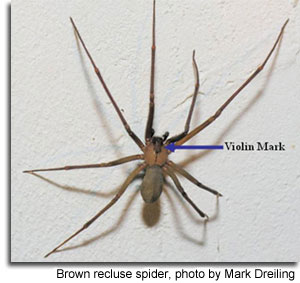
Many of the spiders in Maryland possess venom, but the black widow is the only native Maryland spider that is dangerous to people. All other venomous Maryland spiders either have too little venom to affect people or their venom is specially adapted for their prey.
Brown recluse spiders are not native to Maryland, but on very rare instances they can stow away on packages from the Midwest and the Southwest where the Brown recluses are more common.
Only 10% of Brown recluse bites develop into tissue necrosis (cell death) around the bite area. Recently, many researchers are realizing that many previously diagnosed brown recluse bites were actually methicillin-resistant
Staphylococcus aureus, or MRSA infections. Treatment for MRSA infections and spider bites are similar. Brown recluses can be identified by several characteristics such as: 1) six eyes arranged in pairs, 2) a dark violin-shape on the cephalothorax (head), 3) uniformly light-colored legs (without stripes or bands), 4) 3/8 inch length body and 5) no spines on the legs. Brown recluses are often misidentified. The University of California has an excellent page on brown recluse identification and misidentification
here.
Spider bites are actually quite uncommon, and most spiders will only bite humans in self defense. While spiders have fangs, they are usually too small to leave visible puncture wounds. Many times, spider bites will result in pain, redness, itching and swelling that lasts a couple of days. Spiders rarely bite more than once, so multiple bites are usually caused by insects such as fleas, bedbugs, chiggers, ticks, mites and biting flies.
Although black widow and brown recluse spider bites are rare, care must be taken to properly identify and treat the wound. Healthy adults may only experience mild symptoms but children, the elderly and those with compromised immune systems should be extra cautious.
Guide to Common Spider Groups

Cellar spiders
Family: Pholcidae
Cellar spiders tend to have extremely long, skinny legs with small bodies. Cellar spiders make stringy webs, often in the corner of rooms, to catch flies and gnats. When food is scarce, Cellar spiders will abandon their webs and tap on another spider’s web to mimic captured prey. When the other spider comes out to investigate its “catch”, the cellar spider will eat the unsuspecting spider. Cellar spiders are commonly found in homes, but they typically stay in one place and don't bother people. Cellar spiders are not known to bite people.
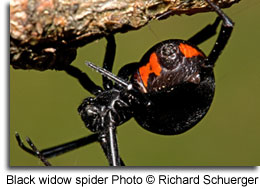
Cobweb spiders
amily: Theridiidae
Black widows
(Latrodectus)
Black widows are distinctive spiders. The females are shiny black with a red hourglass on the bottom of her abdomen while males have a more vibrant pattern on their abdomen consisting of many red and white spots. Male black widow spiders are rarely encountered and are not known to bite humans.
Black widow bites feel like a minor pinprick, but dull pains will soon develop in the area of the bite. The affected area will generally begin to cramp and other symptoms such as sweating, nausea and vomiting may occur.
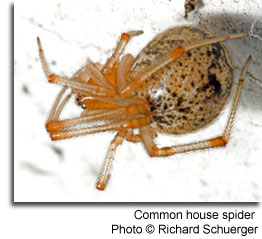
Black widow spiders are cobweb spiders that spend most of their time in their webs. Black widows tend to make their webs in undisturbed, uncluttered areas on porches and in sheds. To discourage them from inhabiting an area, then knock down their webs with a broom or a high pressure hose. In some areas, you can vacuum up spiders and their eggs, but be sure to immediately place the vacuum cleaner bag in a plastic bag, seal tightly, and discard in a container outdoors as this prevents captured spiders from escaping into the home.
Common house spider
(Parasteatoda tepidariorum)
True to their name, common house spiders are frequently found in human dwellings. Like Black widows and other cobweb spiders, common house spiders build messy, tangle webs usually around windows. Common house spiders can have variable appearances. Females are generally mottled gray or tan while the males tend to have a more reddish appearance.
Crab spiders
Family: Thomisidae
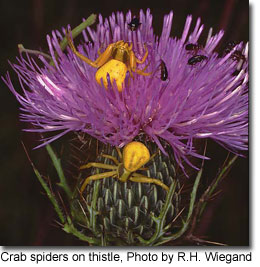
Crab spiders are not active hunters and use the art of camouflage to snag their prey. Crab spiders are named after their crab-like appearance with large front legs that are often held out to the sides of their body. These spiders come in all different colors, many of which are specially adapted to their hunting grounds. For example, the goldenrod crab spider is a bright yellow color which allows it to easily blend in with the yellow petals of goldenrods. Crab spiders are viewed as beneficial to people as they tend to eat many insect pests found in gardens and flower beds. Interestingly enough, scientists believe that the venom of many crab spiders is more potent than most spiders. This allows the crab spiders to quickly subdue prey such as bees. Crab spiders are not known to bite humans, though.
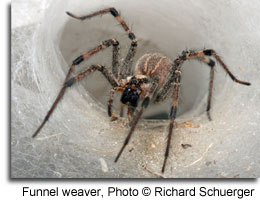
Funnel weavers/Grass spiders
Family: Agelenidae
Funnel weaving spiders look very similar to Wolf spiders, but they make webs and have three rows of eyes. True to their name, funnel weavers make funnel-like webs along the ground in which the spider hides in. When a prey species crosses the web and vibrates it, the spider will jump out and grab its new meal. Because of this feeding strategy, funnel weaving spiders are designed to be incredibly quick and most rarely leave their webs.
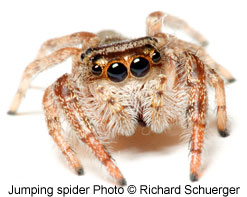
Jumping spiders
Family: Salticidae
Jumping spiders are truly the Casanovas of the Arachnid world. Not only are many jumping spiders brightly colored, but the males put on elaborate songs and dances for the ladies. Jumping spiders are named for their movements which consist of jumps or short, rapid runs. Jumping spiders tend to have a large pair of eyes mounted on the front of a relatively flat-face. The other three pairs of eyes are relatively small in comparison.
Jumping spiders are adept hunters. Their keen eyesight paired with speed allows them to catch prey with amazing accuracy. Jumping spiders do not build webs, but they do use their silk as a tether when they go to pounce on prey. If their aim is off, they can use their silk thread to return to their original location. Jumping spiders are often found in and around human structures, especially in barns and sheds.
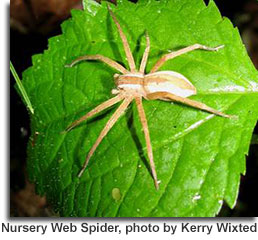
Nursery web and Fishing spiders
Family: Pisauridae
Nursery web spider
(Pisaurina spp.)
Nursery web spiders are large, hairy spiders that usually have a dark stripe running through their eyes down the back of them. Nursery web spiders consist of several species in the genus Pisaurina. Nursery web spiders will carry their egg sacs in their jaws and then will build a “nursery tent” shortly before they hatch. The female will guard the nursery web until the young spiders reach their first molt.
Most adults get up to an inch in size. Nursery web spiders can commonly be found in and around homes, but they pose little to no threat to humans.
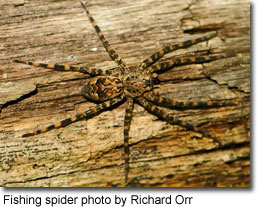
Fishing spiders
(Dolomedes spp.)
Fishing spiders look very similar to wolf spiders in regards to size and coloration. However, fishing spiders tend to have much longer legs, relative to the rest of their bodies and have alternating brown/black bands on their legs. Many species of fishing spiders live near water and often catch small fish, aquatic insects and tadpoles. One exception is the dark fishing spider (Dolomedes tenebrosus) which lives in wooded areas and occasionally seeks refuge in basements.
Orb-weavers
Family: Araneidae
Orb-weavers strongly resemble cobweb spiders. However, true to their name, orb weavers create webs that are organized and have a circular grid. Orb-weavers need structures such as weeds, fences, trees, walls or other upright structures to build their webs. Orb weavers are considered beneficial to humans as they eat many pest insects including the invasive Brown-marmorated stinkbug!
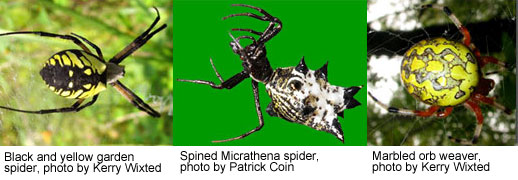
Black and yellow garden spider
(Argiope aurantia)
True to its name, the black and yellow garden spider is often seen n and around gardens. These spiders are orb-weavers, meaning that they spin their webs in a circle or an orb. These webs can be up to 2 feet across, while the spiders themselves can have a leg span of nearly 2.5 inches! Females are much larger than the males, and often times, these spiders will decorate their web with a zig-zag of white silk. Black and yellow garden spiders prefer to build their webs in sunny areas and often will rebuild their webs every day.
Micrathena spiders
Spiders in the genus Micrathena tend to have spiky abdomens and are notorious for weaving webs at face level along trails. If you have ever run into a spider’s web in late summer while hiking in Maryland, then there is a good chance it was a Micrathena web! Micrathena spiders feed mostly on small flies, gnats and mosquitoes. Males do not build webs, rather they let the ladies do all the work. When a male is ready to mate, he will weave a ‘mating thread’ into her web before mating with her. Many times, females will kill the males shortly after mating. Spined Micrathena spiders (Micrathena gracilis) are the most common Micrathena in Maryland.
Marbled orb weavers
(Araneus marmoreus)
Marbled orb weavers are some of the showiest spiders found in our area. The abdomens of these spiders become yellow with black marbled patterns as they mature, and sometimes around Halloween, the yellow turns to an orange color. Most marbled orb weavers hide in rolled up leaves until an unsuspecting prey gets captured in their webs.
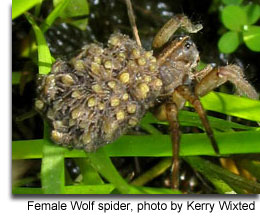
Wolf spiders
Family: Lycosidae
Wolf spiders are agile hunters that live alone and actively hunt prey instead of tending to webs. Wolf spiders have exceptional eyesight and often hunt at night. Their eyes are reflective, so they can often be seen at night by shining a flashlight over them. Wolf spiders tend to be brownish-gray and can grow just over an inch in length. Wolf spiders are often confused with the Brown recluse, but they lack the unmistakable violin-shaped marking behind the head.
Female wolf spiders are very maternal and will carry their eggs in a sac on their back. When the eggs hatch, the female will carry the hatchlings on her back until they are large enough to hunt on their own. Wolf spiders are not aggressive, and like most spiders, will only bite when they feel threatened.
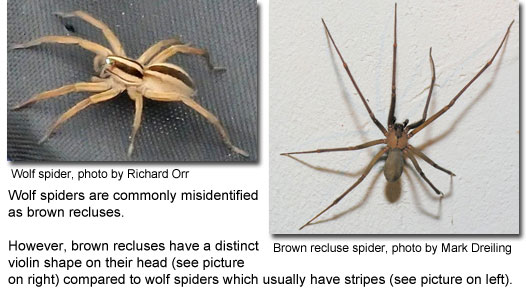
Invite Wildlife to Your Backyard!
For more information, please contact:
Maryland Department of Natural Resources
Wildlife and Heritage Service
Tawes State Office Building, E-1
Annapolis MD 21401
410-260-8540
Toll-free in Maryland: 1-877-620-8DNR
[email protected]
Acknowledgements:
- Cellar spider, photo by Olaf Leillinger
- Black widow spider, photo © Richard Schuerger
- Common house spider, photo © Richard Schuerger
- Crab spiders on thistle, photo by R.H. Wiegand
- Funnel weaver, photo © Richard Schuerger
- Jumping spider photo © Richard Schuerger
- Nursery web spider, photo by Kerry Wixted
- Fishing spider, photo by Richard Orr
- Black and yellow garden spider, photo by Kerry Wixted
- Spined Micrathena spider, photo by Patrick Coin
- Marbled orb weaver, photo by Kerry Wixted
- Female Wolf spider, photo by Kerry Wixted
- Wolf spider, photo by Richard Orr
- Brown recluse spider, photo by Mark Dreiling